Explainer
- Explainer
- Space
‘Puffy-head bird-leg syndrome’: What space travel does to the body
Weird things can happen to the body in space – not least from abrupt changes in gravity as well as weightlessness, radiation and being cooped up. How do astronauts do it?
Andy Thomas had just landed on Earth after 20 weeks in space. He unfastened his restraints, got to his feet and felt a staggering weight in his legs. “I thought, my god, I’ll never walk again.” He turned his head, and the cabin seemed to spin. “I felt nauseated. I just felt listless. My balance was all off,” he recalls. “It just felt awful.”
It was 1998 and Thomas, one of only two Australians who have travelled in space, had just hours earlier been aboard Russia’s Mir Space Station, floating about with other international crew members. After touchdown at NASA’s Kennedy Space Centre at Cape Canaveral, he was whisked into crew rooms and given anti-nausea tablets as he waited out the worst of his body’s reaction to entering back into Earth’s gravity. “I kept still, didn’t move my head, just waited.”
Since the early days of the space race, in the 1950s and ’60s, astronauts have undergone all sorts of regimens to prepare for the adverse effects of space travel and have been scrutinised after their return. Just over 700 people have travelled into space, according to the US Air Force definition, most orbiting the Earth in space stations, including the International Space Station (ISS), China’s Tiangong Space Station, and earlier vessels such as NASA’s Skylab.
Sometimes, journeys are longer than expected. In June, US astronauts Suni Williams and Butch Wilmore were meant to spend just eight days in Boeing’s new Starliner capsule, testing its capacity to dock at the ISS. The mission blew out to some eight months because of concerns about Starliner’s ability to return safely. Until NASA returns them on a vessel from Elon Musk’s SpaceX company in February, they are “safe aboard the space station”, NASA says. “They understood the possibilities and unknowns.” For all the awe space travel inspires, it takes a toll on human bodies. Abrupt changes of gravity, prolonged time in weightlessness, radiation exposure and confinement itself threaten the wellbeing and, sometimes, even the mission, of astronauts. So, what happens to the body in space? And how do astronauts adapt to life up there?
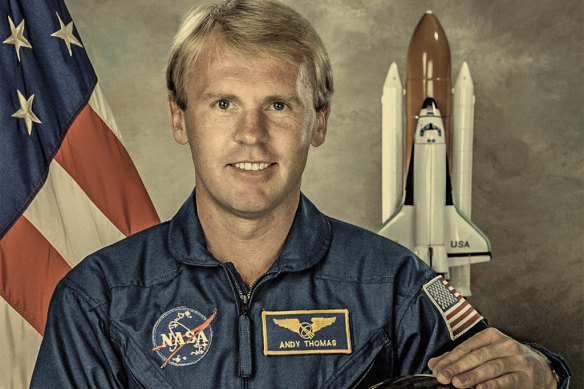
Andy Thomas spent 20 weeks on board the Mir Space Station in 1998. Credit: Getty, digitally tinted
What does zero gravity do to the body?
When a rocket lifts off, it reaches speeds of at least 7.9 kilometres a second to get into orbit. Astronauts strapped to their seats feel gravitational forces up to three times greater than those on Earth. “You have a long period of steadily increasing, crushing force on your body as well as very heavy vibration, especially when you’re still in the atmosphere and shouldering your way through the air,” Chris Hadfield, a former Canadian astronaut who flew on three missions, tells us from Ontario in Canada.
Then, suddenly, the rocket reaches orbit, and the main engine cuts out. There, bodies are weightless – along with everything else. “Zero gravity is a mixed blessing because, on the one hand, it gives you this incredible sense of freedom,” says Thomas. “The downside is, everything has to be tied down. Everything.”
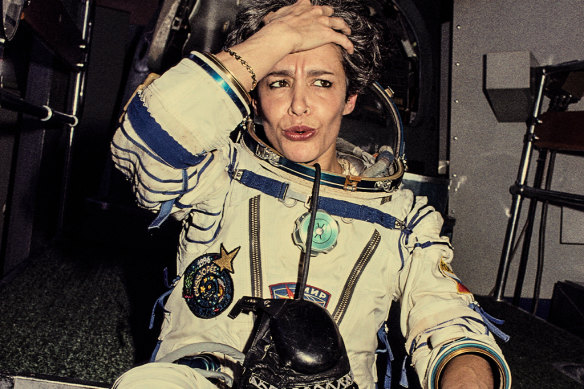
French astronaut Claudie Andre-Deshays between training exercises at the Zvezdniy Gorodok space training facility near Moscow in 1994. Credit: Getty Images, digitally tinted
The first moments in space are the most impactful for human systems, says Emmanuel Urquieta, vice chair of aerospace medicine at the University of Central Florida. Up to 85 per cent of astronauts experience motion sickness immediately. This includes nausea, headaches and cold sweating and can be similar to vertigo, although there is nothing physically wrong with the inner ear. Instead, astronauts feel sick because of a change in the inputs that tell the brain which way is up or down: what the eyes are seeing does not match up with the input that the inner ear sends to the brain. Similarly, the muscles in an astronaut’s back aren’t tensing the way they should if they were in an upright position on Earth.
If you spin and tumble, there is no sense of up or down, says Gordon Cable, an Australian specialist in aerospace medicine. “It’s a conflict that the brain gets very confused about, and that leads to quite substantial motion sickness.” With medication, some astronauts recover quickly, while others take up to 72 hours.
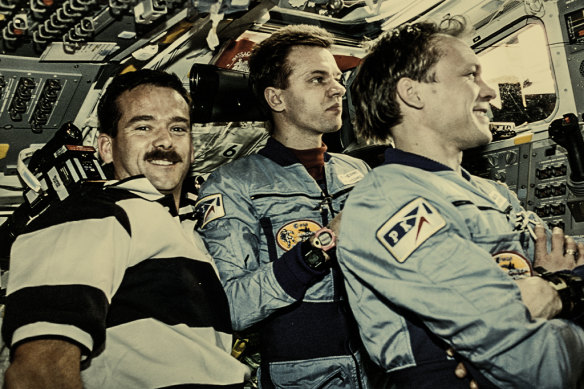
Canadian CSA astronaut Chris Hadfield, Ukrainian-born Russian cosmonaut Yuri Gidzenko, and Russian cosmonaut Sergey Avdeev inspect the Russian Space Station Mir. Credit: Getty, digitally tinted
Hadfield felt nauseous and threw up on his first flight. “You don’t want your first two days in space to be non-productive, so we take medication anticipating that’s going to happen,” he says.
On the other hand, Thomas considers himself to be one of the lucky ones, on the way up at least. “I felt like I’d been there all my life,” he says. “I had a little bit of stomach awareness, but I did not throw up. I was not incapacitated.”
Paul Scully-Power was the first Australian to go into space, on the fifth flight of space shuttle Challenger, in 1984. He also claims to have a strong stomach. In fact, he was a NASA instructor on a so-called “vomit comet” – one of the aircraft that take astronauts in training on a parabolic flight path that allows them to experience weightlessness for at least 20 seconds. “A lot of people throw up,” Scully-Power recalls.
‘Just go stand on your head for 12 hours and watch what happens ... It’s not comfortable, but you get used to it.’
If a human spends any longer amount of time in a weightless environment, the way fluids move inside the body will start to change. Astronauts call one visible symptom of this “puffy-head bird-leg syndrome”: the face begins to swell and redden, veins protrude, while legs appear skinnier. On Earth, gravity pulls blood down, and our heart then works to pump it back up. In space, fluid flows to the head and chest. “If you want to know what it’s like,” says Hadfield, “just go stand on your head for 12 hours and watch what happens to your face and to your tongue and to your sinuses; it’s like that the whole time. It’s not comfortable, but you get used to it.”
The cardiovascular system has to adjust, too. Says Urquieta: “The first thing that it does is say, ‘OK, how can I get rid of these extra fluids?’ So astronauts start urinating and have decreased thirst.” Astronauts lose about 1.5 litres of fluid in the first few days of space flight (the human body, on average, carries 5 litres). Red blood cell and bone marrow production drops (more on this later). On longer flights, the heart morphs in shape from roughly triangular to spherical as it’s no longer drawn down by gravity. This reverses after the astronaut returns to Earth.
Of greater concern are changes in fluid in the skull that are thought to affect eyesight. About 70 per cent of astronauts who have been on the ISS have symptoms of a condition known as Spaceflight Associated Neuro-ocular Syndrome, according to NASA. They include swelling of the optic nerve, folds in the retina and changes in the eyeball shape. Thomas noticed a swing in his vision when he was in space but can’t rule out whether this coincided with simply ageing. “I started wearing glasses occasionally prior to the flight to read, but I needed them much more when I was flying.”
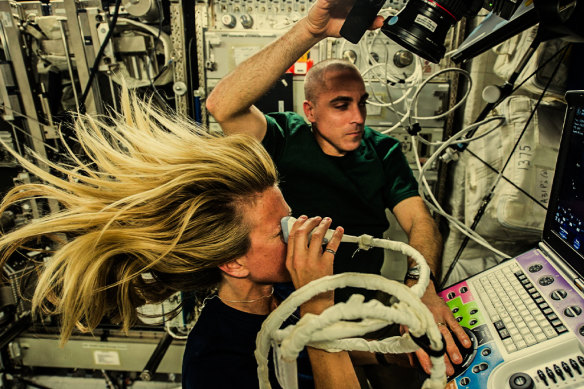
Astronaut Karen Nyberg, helped by astronaut Chris Cassidy, performs an eye ultrasound scan on the International Space Station in 2013.Credit: Getty Images, digitally tinted
Other changes are benign – fun, even. With his spine uncompressed by gravity, Thomas grew about three centimetres taller. Back on Earth, that reverses almost immediately. The health issues associated with weightlessness have led scientists to consider how to create artificial gravity, which could include rotating the spacecraft, part of it, or the people in it on a centrifuge. For now, it is the stuff of science fiction. The movie 2001: A Space Odyssey depicted a spacecraft with a giant rotating wheel onboard the Jupiter spacecraft that crew members ran in.
Coming back to Earth also wreaks havoc with the body. Astronauts will drink water before returning to Earth to replace the fluid lost when they arrived in space. This helps prevent fainting from low blood pressure upon return. And, depending on the length of time in space, some astronauts, such as Thomas, have trouble walking as their muscles and bones adjust to working against gravity again. Teams of military personnel, engineers and physicians will travel to the site where a capsule has landed to help the astronauts out of the spacecraft. Russian Soyuz capsules typically touch down in the Kazakhstan steppes, while SpaceX’s capsules splash into the ocean.
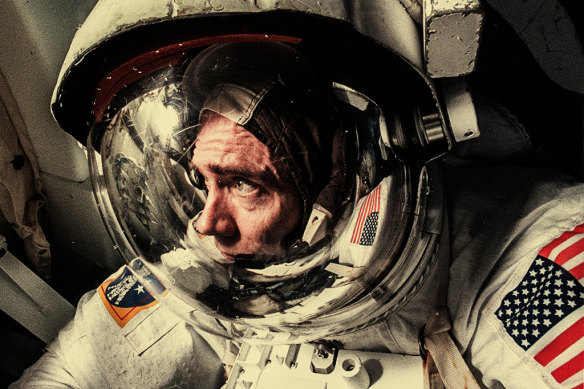
Daniel Barry, a mission specialist, during an underwater simulation of a space walk at the Johnson Space Center in Houston in 1999.Credit: Getty Images, digitally tinted
How do you exercise, eat and sleep in space?
Even after adjusting to space, an astronaut’s body will degrade simply from being there. In a way, these changes mimic some of the processes of ageing, says Rihana Bokhari, acting science officer of the NASA-funded Translational Research Institute for Space Health. “The changes in bones, the thinning of the bones, is similar to what you see in osteoporosis in older people on Earth. Similarly, muscle wasting is what you see as people age; if you don’t use it, you lose it,” she tells us from Houston. Most of the damage is reversible, she says.
Chris Hadfield puts it this way: “Your body starts to stop building your skeleton. Because if you don’t have to fight gravity, there’s no benefit in building a strong skeleton.” Astronauts lose muscle strength and bone mass at an average of about 1 per cent per month. However, says Emmanuel Urquieta, this can vary greatly from person to person. “You see people who lose 30 per cent of their muscle strength. Then, on the other side, you see people who actually gain 20 per cent muscle strength in space.”

Australian-US astronaut Andy Thomas runs on a treadmill on the Mir Space Station in 1998.Credit: Getty, digitally tinted
As on Earth, how intensely an astronaut exercises (the ISS schedules two hours daily), what they eat, how they sleep, the stress they’re under, and their body type are thought to be behind these variations. Hadfield lost about 7 per cent of his bone mass, mostly from his hips and femurs, yet gained muscle from a two-hour daily workout. Of course, weightlifting doesn’t work in microgravity. So astronauts on the ISS use an exercise device that, when their force is applied to it, creates a vacuum in cylinders that creates resistance.
Thomas did not have access to this machine on Mir, which he suspects contributed to his floppy legs on his return. (He eventually rebuilt his strength, lifting weights on Earth.) He did run on a treadmill daily in space. “It takes a bit of getting used to but once you get used to it, it’s actually quite good,” he says. A bungee system connected to a harness kept him from floating off. Jogging is easier: he even timed his run to cover the width of Australia from west to east one day as the space station cruised over the continent. It took about 10 minutes. Sweat doesn’t float in droplets either but sticks to the skin, pooling in joints and folds. “So you end up just basically wet,” Thomas says.
Facial swelling and nose congestion also affect an astronaut’s sense of taste. Then there are the meals, which Hadfield likens to what you might pack on a six-month camping trip. “You can heat up packages; you can inject hot water,” he says. “It’s fine, but I wouldn’t go to space for the food. [But] I came back very healthy.” Automated spacecraft occasionally deliver a small amount of fresh fruit and vegetables, among other essentials. Still, most meals are packaged to ensure a long shelf life. This also serves a practical purpose, says Thomas. “If you want to eat something like peas, just imagine what a nightmare that could be. So you have to have them in some kind of sauce that causes them to congeal together, and they have to be in a small bag, which opens at one corner, and you reach very carefully in with a spoon.”
‘We have whole teams of people in Mission Control in Houston, in Munich, in Montreal, in Moscow and in Tokyo that are scheduling our time.’
On the ISS, an astronaut’s schedule is accounted for down to five-minute increments, says Hadfield. “We have whole teams of people in Mission Control in Houston, in Munich, in Montreal, in Moscow and in Tokyo that are scheduling our time.” Astronauts work regular shifts and sleep for eight hours. But on the ISS they battle against disruption to circadian rhythms as they orbit the Earth every 90 minutes, exposing them to 16 sunrises and sunsets per day. Each time the sun sets, the body produces melatonin to cause drowsiness.
Astronauts are able to keep their sleeping environment dark, but they have to put up with noisy fans that prevent the carbon dioxide they are exhaling from bubbling around their heads. Thomas recalls having the option of sleeping on the wall or the floor. “There is no up or down.” Still, earthly habits were difficult to shrug off, and he stayed on the floor. “Sleeping on the wall, it just felt wrong, even though it didn’t matter.”
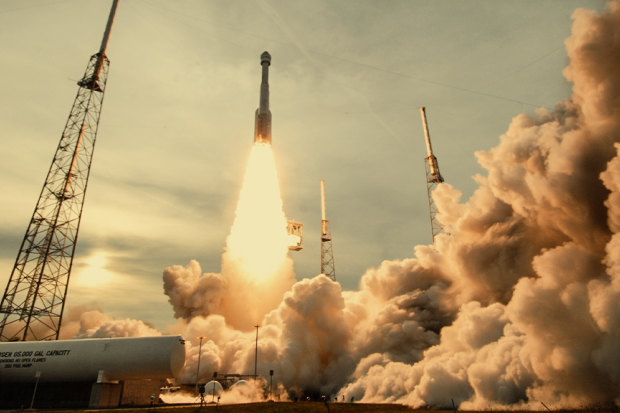
The Atlas V rocket carrying the Boeing Starliner spacecraft lifts off at Cape Canaveral on May 19, 2022. Credit: Getty, digitally tinted
What are the effects of space radiation?
On Earth, we’re surrounded by magnetic fields that trap high-energy radiation particles from outer space. “The Earth sits in kind of like a protective bunker – we are spoiled on the Earth. We are protected from what is really a normal situation in the entire universe, and that is that the universe is this seething bath of ionising radiation,” says Gordon Cable.
Two main types of radiation can be particularly concerning for astronauts. The first is when explosions on the sun emit radiation into space, producing what are called solar particle events. Exposure to a solar particle event, depending on its intensity, can result in acute sickness and an increased risk of cancer, says Rihana Bokhari. “For the most part, if you can get behind shielding, you’ll probably be fine.” Water is one effective shield – on the ISS, the crew sleeping quarters are lined with a hydrogen-rich material.
The other form is galactic cosmic radiation, which comes from outside our solar system. Scientists believe it carries mostly a low dose of radiation. It’s concerning to scientists because it can pass unimpeded through a typical spacecraft or the skin of an astronaut. “There are some parts of it that are pretty dangerous,” says Bokhari. “And those parts we do not know how to shield against, and that is the scary part. The less scary part is that there’s not very much of it.”
Space agencies limit the amount of radiation an astronaut can be exposed to in their lifetime and during a single event – NASA astronauts generally cannot exceed 600 millisieverts over their career, while European, Canadian and Russian astronauts cannot be exposed to more than 1000 millisieverts (a chest X-ray is 0.1 to 0.3 millisieverts). To put this in context, says Urquieta, 1000 millisieverts is roughly what an astronaut would encounter on a mission to Mars and back. “That will put you in a position of probably one mission only, or we’ll need to find new ways to protect the astronauts from radiation.” Neither Hadfield nor Thomas – who each went into space three times – came close to their career limits for radiation.
“As I get older, I think about it, and I watch with interest to see how the health of other astronauts in my age group is,” says Thomas. “When you’re orbiting the Earth, you’re actually quite shielded from the radiation. You’re still close enough to the Earth that you are under the influence of the Earth’s magnetic field, which is why much of the radiation is deflected.”
Space agencies have monitored astronauts over their careers and are yet to find adverse effects from their radiation exposure. “For low Earth orbit, we are pretty good, given that astronauts are mostly protected by the Earth’s magnetosphere,” says Urquieta. “But for longer missions, further from our planet, I think radiation is the most uncertain thing.”
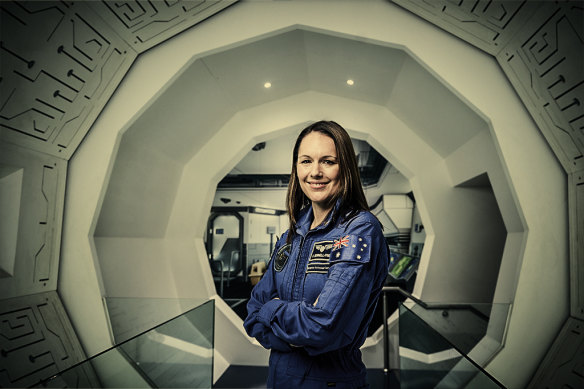
Katherine Bennell-Pegg has completed training with the European Space Agency. Credit: Australian Space Agency
How does space mess with the mind?
Katherine Bennell-Pegg, 39, underwent extensive psychological tests to get into the European Space Agency’s astronaut training program, which she finished this year, the first Australian to do so. (Bennell-Pegg is, technically, the first fully trained Australian astronaut because Thomas and Scully-Power had to take up dual US citizenship to join NASA’s program.) Calmness under pressure and not taking or laying blame where there was none to be attributed are qualities she got the sense were desirable (the results were not shared with contenders). “They were also really looking for people who had an optimism bias and would make the best of any given situation.”
“For example, if something goes wrong during the spacewalk, you make a mistake, drop a tool or some gear, you’re able to recover as best as you can and get on with getting the job done. If you’re on the ground and there’s uncertainty about your training or your flight that you’re able to maintain your motivation regardless. And also not dwell on negative things, don’t get caught up on them.”
Hadfield says through NASA’s selection process and training program, “you find out if it’s a life you want”. “And then you’re eligible for assignment to a spaceflight, and that could be years. And you train with a backup crew. So by the time you get to space, hopefully, we are not going to be surprised by somebody’s psychology.”
‘They said, No, you’ve been up there for 100 days. I could not believe it.’
For most of Andy Thomas’ Mir mission, he was with just two cosmonauts, learning to speak Russian, but “not nearly enough”. While the experience was unique, he found the daily routine on this early flight hard to adjust to. “What you’ve got to deal with is the monotony. I liken it to the movie Groundhog Day. Every day is like every previous day,” he says. “The psychological challenge was to find a way to use the limited resources that were available to provide a good balance between work and recreation and rest,” he says. “Once I figured out how to do that, the experience actually became very serene and tranquil.” One of his remedies? He spent an afternoon each week drawing. “I would draw views out the window, views of the spacecraft, views of my colleagues when they did a spacewalk outside,” he says. “I had a great time with it.”
Eventually, he ditched a calendar he’d planned to count the days on. “Time just flowed fluidly and easily,” he says. “They called me up one day and said, ‘Do you know what today is?’ And I said something like, ‘It’s Tuesday, isn’t it?’ They said, ‘No, you’ve been up there for 100 days.’ I could not believe it.” He reflects now on the historical significance of his 20-week journey: “I was flying on a Russian spacecraft with two cosmonauts, a space station that was built as part of the response of Soviet Russia to the Cold War – and it was just incredible to actually be doing that. It was kind of bizarre, but it was also unique, and I feel very privileged.”
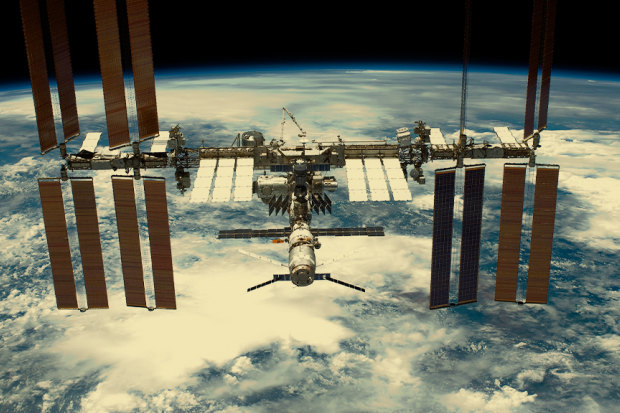
The International Space Station orbiting Earth as seen from NASA space shuttle Endeavour. Credit: Getty, digitally tinted
Hadfield, who also flew on Mir, says life on the ISS is different. “Mir had some real limitations in power,” he says. This meant Mir was unable to receive as much equipment and supplies or return as many experiments compared to later space stations. “The International Space Station is the opposite. It’s 15 nations, and it has great reserves of power and recycling, and vehicles coming and going, so you can take experiments up and down. It’s a very busy place.” (The first pieces of the ISS were launched in 1998 and NASA plans to decommission it sometime after 2030.)
How did Hadfield feel about the risks? “You’re not there for yourself,” he says. “You took an enormous risk on behalf of space exploration and research to get there. And the whole time that you’re there, you could listen to meteorites ricocheting off the outside of the hull, and you’re only seconds away from all kinds of serious emergencies. It’s a life of service and a serious one.”
Bennell-Pegg, who is waiting for a spot on a mission, takes a similar view: “We’re building step by step on human knowledge for what it takes for humans to live and work in space, to do meaningful work up there, to push, you know, the frontiers of our knowledge,” she says. “And in doing so, yes, we have those risks, but those risks, in a way, are beneficial to those back on Earth because we can use them to help treat diseases back there, and it’s an honour to be part of that.”
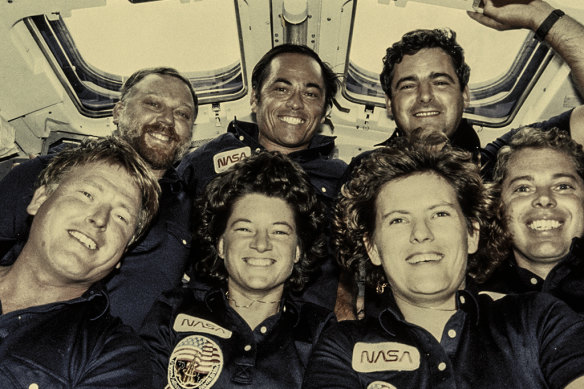
Australian-US astronaut Paul Scully-Power (top left) with the crew of NASA’s STS 41-G space shuttle Challenger in October 1984.Credit: Getty, digitally tinted
Disasters loom large in space exploration history. In 1971, three cosmonauts died in space during a Soyuz 11 mission while departing the first experimental space station after three weeks on board. In 1986, NASA space shuttle Challenger exploded a minute after lift-off, killing all seven crew members. And in 2003, another shuttle, Columbia, disintegrated as it re-entered the atmosphere, killing a further seven astronauts. Scully-Power, who had completed his mission onboard Challenger just over a year earlier, describes the decision to go into space as “really simple”. “It’s the only binary decision you will ever make in life; you either live or you die. There’s nothing in between. It’s not like walking across the road where you might or might not be hit, and if you are, you might not die. In space, it’s not like that, it’s either one or the other.”
In spite of the risks, the moments of sheer wonder strike home. Thomas recalls being on a later mission and spacewalking outside the ISS. “I was at the top of the space station and Mission Control said, ‘Heads up, we’re coming over Australia’, and I could see Australia pass beneath my feet, 250 miles away,” he says. “The other great moment was when we’re on the dark side of Earth, away from the sun, in pitch-black darkness. And I was at the top of the space station where there were no lights, and I looked at the modules of the space station strung out like a string of railroad cars, but nothing holding them up, just there by themselves. And beyond that, I knew I was looking to infinity.”
Fear didn’t enter into it. “I felt a sense of wonder, just what an amazing thing I’m doing right now. Here’s this kid from Adelaide whose grades in school were nothing to write home about, and look what I’m doing now! What an amazing experience.”
Get fascinating insights and explanations on the world’s most perplexing topics. Sign up for our weekly Explainer newsletter.
Let us explain
If you'd like some expert background on an issue or a news event, drop us a line at explainers@smh.com.au or explainers@theage.com.au. Read more explainers here.